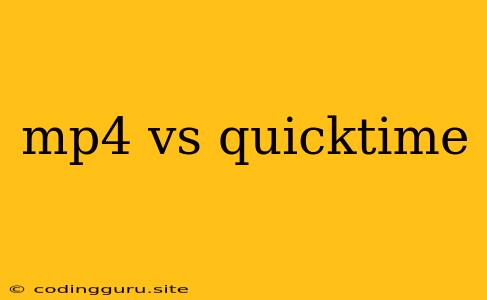MP4 vs QuickTime: Which Format Reigns Supreme?
In the ever-evolving landscape of digital media, choosing the right video format can be a daunting task. Two popular contenders, MP4 and QuickTime, have long dominated the scene, each with its own unique strengths and weaknesses. But which format reigns supreme? Let's delve into the intricacies of MP4 and QuickTime to determine the victor in this video format showdown.
MP4: The Versatile Champion
MP4, short for MPEG-4 Part 14, has emerged as the undisputed king of video formats, boasting remarkable versatility and widespread compatibility. It's the go-to format for a multitude of applications, including streaming, downloading, editing, and sharing videos across various devices.
Here's what makes MP4 so popular:
- Universal Compatibility: MP4 enjoys widespread support across a vast range of operating systems, web browsers, and multimedia players, making it accessible to a broad audience.
- Superior Compression: MP4 employs advanced compression algorithms that deliver high-quality video without sacrificing file size. This makes it ideal for storing and sharing videos efficiently.
- Flexibility: MP4 supports a wide range of codecs, allowing users to choose the best compression method based on their specific needs.
- Support for Multiple Audio Tracks: MP4 can accommodate multiple audio tracks, allowing for multilingual content or different audio experiences.
- Subtitles and Chapters: MP4 supports subtitles and chapter markers, enhancing accessibility and navigation for viewers.
QuickTime: The Legacy Player
QuickTime, developed by Apple, has been a mainstay in the video world for decades. While its popularity has waned with the rise of MP4, it still holds a significant position, particularly within the Apple ecosystem.
QuickTime's key strengths:
- Native Integration with Apple Devices: QuickTime seamlessly integrates with Apple devices, offering a familiar and user-friendly experience.
- Support for Specialized Formats: QuickTime can handle a wider range of video and audio formats, including those not commonly supported by other players.
- Powerful Editing Features: QuickTime Pro, Apple's professional-grade video editor, provides a suite of tools for advanced video manipulation.
MP4 vs QuickTime: The Head-to-Head Showdown
Now that we've examined the core strengths of each format, let's pit them against each other to see who emerges victorious:
Compatibility: MP4 takes the lead, offering near-universal compatibility across platforms and devices. QuickTime, while excellent on Apple devices, struggles to maintain the same level of compatibility elsewhere.
Compression: MP4's advanced compression algorithms deliver superior file size reduction without compromising video quality. QuickTime, while capable, generally produces larger files.
Features: MP4's support for multiple audio tracks, subtitles, and chapters provides a more comprehensive viewing experience. QuickTime, while offering basic features, lags behind MP4 in this regard.
Overall Versatility: MP4's versatility in terms of compatibility, compression, and features makes it the clear winner. It's the go-to choice for users who need a reliable and widely supported format.
The Verdict: MP4 Wins!
While QuickTime still holds its place in the Apple ecosystem, MP4 reigns supreme as the versatile video format of choice. Its universal compatibility, superior compression, and comprehensive features make it the ideal option for streaming, downloading, editing, and sharing videos across platforms.
Here are some additional tips for choosing the right format:
- Consider Your Audience: If your target audience primarily uses Apple devices, QuickTime might be a suitable option. However, for broader reach, MP4 is the safer bet.
- Prioritize File Size: If file size is a primary concern, MP4's efficient compression makes it the better choice.
- Focus on Features: If you require features like multiple audio tracks or subtitles, MP4 offers more options.
Conclusion:
Ultimately, choosing between MP4 and QuickTime depends on your specific needs and priorities. However, for most users, MP4's superior versatility, compatibility, and compression make it the winner in this video format battle.
